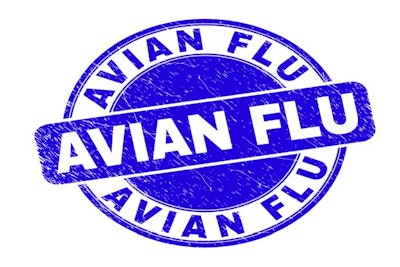
Following the country’s recent official declaration of freedom from highly pathogenic avian influenza (HPAI), poultry exports from all parts of Japan can now resume.
This lifting of restrictions covers trade of chicken and eggs to Hong Kong and Singapore, according to Japan’s agriculture ministry in the last week of June.
This resumption of trade is important to the nation’s poultry sector. In 2021, Japan exported chicken worth 980 million yen (JPY; US$7.2 million) to Hong Kong out of its total exports of this meat of JPY1.3 billion.
Over the same period, Japanese egg exports to all destinations amounted to JPY5.87 billion, the ministry reports. This includes trade worth JPY5.73 billion to Hong Kong, and JPY130 million to Singapore.
Last month, Japanese veterinary authorities officially declared the HPAI situation “resolved.”
Declarations were made to the World Organisation for Animal Health (WOAH).
Since November of last year, a total of 25 HPAI outbreaks in poultry were confirmed in Japan. Apart from one outbreak at a zoo, all cases were detected on poultry farms. In two of the early outbreaks, the H5N8 HPAI virus serotype was detected. Birds tested positive for the H5N1 virus variant at the other 23 locations.
In flocks each comprising between 400 and 170,000 birds, a total of 1.89 million poultry were directly impacted by these HPAI outbreaks in Japan over the 2021-2022 winter. Most recent cases were confirmed in mid-May.
Widespread outbreaks reported in Vietnam
Between February 1 and June 8, the H5N1 HPAI virus was detected in 17 village poultry flocks across Vietnam.
According to the latest WOAH notification, these outbreaks occurred in 11 provinces in six of the country’s eight regions. Each affected flocks ranged from 1,400 to and 4,300 birds.
Since this disease series began in October of last year, 26 outbreaks have been confirmed to WOAH. These have involved a total of almost 43,000 poultry, of which around 13,700 birds died.
Avian flu situation elsewhere in Asian poultry
Detection of the H5N1 HPAI in the Mid-Western region of Nepal represents a significant development in the disease situation in Nepal.
Previous cases in the current disease wave — which started in January of this year — have been in the Eastern and Central regions.
Latest cases were confirmed on a farm in Bheri zone comprising 2,176 commercial broilers and turkeys as well as a small mixed backyard flock.
So far involved in the 34 confirmed HPAI outbreaks in Nepal so far have been around 274,700 poultry.
In the Philippines, the H5N1 HPAI virus was first detected in January of this year, according to official notifications to WOAH.
Reporting the most cases is the northernmost main island of Luzon. Here, the number of confirmed outbreaks has reached 84, directly impacting more than 280,000 poultry.
Latest 33 outbreaks to be reported started between March 30 and June 7. Affected were poultry on 13 farms and in 20 backyard flocks — a total of 119,000 birds — in six different provinces.
Meanwhile, a further four outbreaks have been confirmed on the island of Mindanao between March 30 and May 4. Involving a total of just over 2,000 poultry, two outbreaks were on farms, and one each in a backyard and a village flock in three different provinces.
Now comprising 20 outbreaks, this disease series on Mindanao has directly impacted around 15,100 poultry so far.
In Taiwan, a small group of native chickens was destroyed in early June after one of the birds tested positive for the H5N2 HPAI virus variant. The infection was detected at a slaughterhouse in the Wanhua district of Taipei city.
This outbreak brings to 34 the number of confirmed HPAI outbreaks in Taiwanese poultry since November of 2021.
Cases detected in wild birds in Kazakhstan, Japan
Following a hiatus since November of 2020, the H5N1 HPAI virus has been detected again in Kazakhstan.
According to the WOAH report, the affected birds were found in the Caspian Sea area. The species could not be identified.
Furthermore, across the continent in Japan, a further 29 wild birds have recently tested positive for HPAI.
South Korea prepares for next HPAI season
As part of the preparation to avoid another HPAI outbreak wave starting in the coming fall/autumn season, South Korean authorities have been carrying out inspections of poultry farms. These started in May and by the third week of June, around 60% of the nation's 3,300 chicken and duck farms had been assessed, reported the agriculture ministry.
Around 700 failures were noted, mainly in respect to poor maintenance of poultry buildings and fences. Some premises were found to have less-than-ideal facilities for handwashing and changing of clothes and footwear at the farm entrance.
On duck farms where rice straw is used, the ministry is urging farmers to ensure bedding supplies are covered in order to reduce the risk of contamination by wild birds and other animals.
Between November of 2021 and early April, South Korean authorities registered with WOAH 47 HPAI outbreaks on poultry farms. Directly affected were just under five million birds.
Three new human influenza cases in China
The number of confirmed human cases of avian influenza A(H5N6) in Mainland China since 2014 has risen to 79.
According to the Government of Hong Kong Special Administrative Region, the latest case was a 58-year-old man from Ganzhou in Jiangxi province. In early June, he developed symptoms after being exposed to poultry at a market. Following admission to hospital, his condition was described as “critical.”
Meanwhile, two new cases in the Western Pacific region of avian influenza A(H9N2) have been registered with the World Health Organization (WHO).
Reported in the first days of June, both occurred in young boys in China. Symptoms included a mild fever and cough.
A two-year-old in Bijie city in Guizhou province became unwell in early May after exposure to a live poultry market. Subsequent samples from the market and the boy’s home were positive for a virus of the H9 family.
Previously, a five-year-old had shown mild symptoms in Hunan province. Although he had not visited it, his home was within 500 meters of a live poultry market in Yueyang city. Samples taken as part of an investigation tested positive for H5 and H9 avian influenza virus A-serotypes.
No close contact of either child has shown any symptoms of infection.
Since the first case in December of 2015, 74 cases of human infection with avian influenza A(H9N2) including two deaths have been reported to WHO in the Western Pacific Region.
View our continuing coverage of the global avian influenza situation.
















